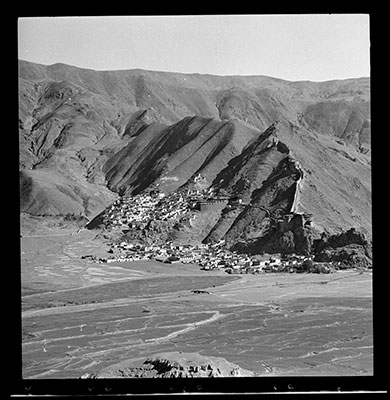
2001.59.15.66.1 (Film negative)


2001.59.15.66.1 (Film negative)

Hugh E. Richardson
Hugh Richardson
1949
Chyongye Valley Region > Chyongye
2001.59.15.66.1
55 x 55 mm
Negative film nitrate
Donated August 2001
The executors of the estate of Hugh E. Richardson
Richardson's 1949 tour of the Yarlung and Chyongye valleys
Negative Album 9 No. 66
‘High Peaks, Pure Earth’, Hugh Richardson, London, Serindia Publications, 1998 [view list of illustrations]
Manual Catalogues - Notes on negative album (slip cover) - 'Drikhung. Chongye. etc.' in Richardson's hand in white. (Yellow spine label) 'DRIKHUNG. CHONGYE. KOTSHAL. RGYAMA. Ganden 1948'. (Cover) - '9 DRIKHUNG. CHONGYE. YARLUNG. GYAMA. GANDEN' [KC 15/5/2006]
Manual Catalogues - Notes in negative index - Folio 66. 'do' ['Phyong-rgyas from bang so] [KC 30/5/2006]
Manual Catalogues - Richardson's Handlist, Negative book '9' 'Drikhung, Chongye etc.' [no] 60. ' Phyong-rgyas is in a valley south of the Brahmaputra at Rtse-thang, and west of the Yarlung valley. There is a dzong on the site of a palace of the early kings called 'Phying-ba stag-rtse; and also a monastery, Ri-bo-bde-chen, of the Dge-lugs-pa sect. East of the village in a small valley are the tombs of the kings of Tibet. See Mkhyen-brtse p.130 and G. Tucci. The Tombs of the Tibetan Kings. Rome 1950.' [KC 30/5/2006]
Manual Catalogues - Richardson's Handlist, Negative book '9' 'Drikhung, Chongye etc.' [nos] 64-69 . (especially 67-9) Burial mounds of the kings etc. See Tucci. Tombs.' [KC 22/5/2006]
Research publication -
Other Information - Location: Richardson wrote an article about the location and the historical significance of the early burial grounds in the Chyonggye valley near Yarlung in Central Asiatic Journal , 8,2 (1963), pp. 73-92 reproduced in High Peaks, Pure Earth , London, Serindia Publications, 1998, pp. 219-233. "'Phyong-rgyas is some sixty-five miles south-east of Lhasa, near the head of a tributary of the Yar-lung Chu which flows south into the Gtsang-po near Rtse-thang. There, in brooding and majestic solitude, rise the burial mounds of the kings ... . Not far away to the north, at the foot of the hills which enclose the valley, is the village of 'Phyong-rgyas dominated by its rdzong ; and on a sheltered hillside above the village there is the Dge-lugs-pa monastery of Ri-bo bde-chen. Higher up the steep ridge on which the rdzong stands are the ruins of what is traditionally identified with Phying-ba'i Stag-rtse, the ancient stronghold of the Tibetan kings." (219-220) Also, "About twelve miles up the ['Phyong-rgyas] valley and visible from a considerable distance are the brooding forms of the great burial tumuli ( bang-so ) (1949) of the Tibetan kings." (320) "The photographs show that some of the surviving mounds are larger than others. The smaller mounds are those attributed to Ljang-tsha Lhas-bon, Mu-rug and Mu-ne Btsan-po. Neither of the first two was enthroned as king ... [and the last] may not have been enthroned as king." (225)
For Citation use:
The Tibet Album.
"Settlement of Chyongye with burial mound"
05 Dec. 2006. The Pitt Rivers Museum.
<http://tibet.prm.ox.ac.uk/photo_2001.59.15.66.1.html>.
For more information about photographic usage or to order prints, please visit the The Pitt Rivers Museum.
© The Pitt Rivers Museum